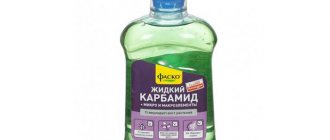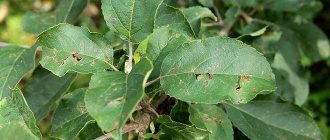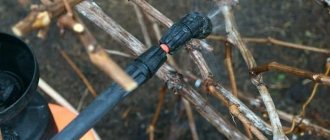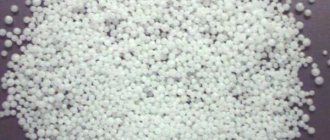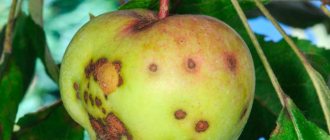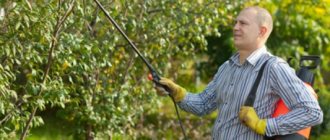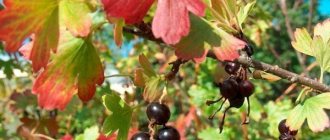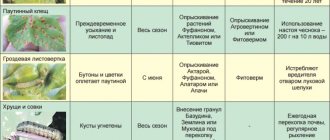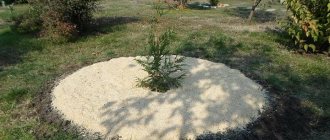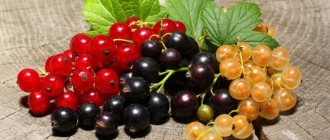Composition of urea, its properties as a fertilizer
Some summer residents are not sure whether urea is a nitrogen fertilizer or is it a complex fertilizer? The percentages of the components that make up urea make it possible to use urea for flowers, berry bushes, vegetables, and fruit trees, because the content of the active element in the fertilizer reaches 46%. White granules of domestic production are perfectly soluble in water.
Once in the soil, urea changes its original formula (H2N-CO-NH2): the composition of the fertilizer becomes ammonia (instead of amide), and then nitrate. Transformations occur slowly, which is convenient for feeding crops. In conditions of nitrogen deficiency, liquid fertilizing with urea is what is needed for plants in the garden.
The price of fertilizer is low. The cost of other nitrogen fertilizers is much higher.
Fertilizer must be stored correctly. It cannot be mixed with other compounds.
Direct contact with granules is harmful to human skin - you must work with gloves.
What is urea and how to use it?
Urea (carbamide) is a mineral fertilizer with a 46% content of nitrogen compounds. Among all known mineral fertilizers, urea is the most nitrogen-containing, since other fertilizers do not contain such an amount of nitrogen. Can be used for both primary and additional feeding of garden and vegetable crops.
Initially, cattle urine was used to produce urea, and fertilizer was obtained by evaporation (hence the name - urea). Now urea has the form of white granules, sometimes yellowish, odorless and capable of rapid dissolution in water.
Advantages and disadvantages of urea
Like any drug, urea has its advantages and disadvantages, and the pros far outweigh the cons:
- does not leave burns on the green mass of plants;
- allows you to collect much more harvest from trees and berry fields in the fall;
- helps fight pests and pathogens;
- instantly absorbed by plants;
- within two days after treatment with urea, plants accumulate a large amount of nitrogen;
- if there is a threat of frost, treatment with a urea solution will stop flowering, which will help avoid shedding of flower stalks;
- saturates seedlings with protein in sufficient quantities;
- has a slow period of decomposition in the soil and is washed out to a small extent from the upper layers of the earth;
- Urea granules are quickly soluble and do not produce sediment.
The disadvantages include these:
- when the soil is oversaturated with nitrogen, seed germination decreases;
- does not mix with other, especially alkaline, drugs.
The principle of action of urea
The first 3 days after the fertilizer enters the soil, the urea composition is transformed. Thanks to enzymes and bacteria, the soil produces ammonium carbonate. Contact with air transforms the substance into ammonia gas.
It is not enough to add fertilizer to the ground; it must be embedded deeper, otherwise part of the composition will be lost, especially on alkaline or neutral soils.
To avoid a decrease in the effect of using urea, the depth of placement of Urea fertilizer granules should be at least 8 cm. It is not recommended to treat plants during the budding period.
Rules for working with urea
When working with any drugs and fertilizers, you must adhere to safety rules.
Urea is no exception:
- You should work with the drug in the morning or evening, without strong gusts of wind, or better yet, without it at all;
- work is carried out using protective equipment - gloves, respirator, goggles;
- spraying with urea solution is carried out using a special sprayer;
- After completing work, wash your face and hands with soap.
Let's celebrate! Urea is simply necessary in any household, as it will help saturate the plants with the necessary nitrogen and help rid the area of pests.
Pros and cons of feeding plants with urea
In spring, urea shows its best qualities. Granular fertilizer, obtained chemically from inorganic compounds, helps:
- quickly increase the concentration of nitrogen in plant cells (2 days from the moment of spraying);
- slow down flowering processes, reducing the risk of flowers falling off;
- increase the amount of proteins.
Urea also:
- disintegrates slowly and lingers in the ground for a long time;
- dissolves without sediment;
- destroys parasites;
- does not burn the leaves of garden crops, trees and shrubs when they are sprayed.
If the instructions for using urea are not followed, the substance can harm young shoots, therefore, when diluting, the required proportions must be strictly observed.
Before you dilute the fertilizer and start watering the garden, you should remember that the composition reduces the acidity of the soil and is quickly washed away by rain. But even taking into account these disadvantages, it is not possible to replace the fertilizer with another without loss of effectiveness. Spraying with urea encourages plants to increase their mass, acquire rich color, and increase productivity.
If the dosage is calculated incorrectly, the seeds take a long time to germinate. It is possible to dilute urea fertilizer for plants in early spring only if the recommended standards are observed. After all, the result of incorrect application of fertilizer will be the release of ammonia gas.
Autumn treatment of the garden against diseases and pests with urea. Properties of urea
Experienced gardeners know that in order to get a high harvest in the new season, they need to provide proper garden care in the fall, in advance of winter. This care includes:
- pruning old branches;
- whitewashing of trunks.
However, it is not recommended to limit yourself to such actions only. It is very important to properly treat the garden with urea against pests and diseases in the fall.
Any plants need nitrogen fertilizers to ensure good growth, ovary formation and fruit ripening. And with the onset of autumn, fruit bushes and trees need nitrogen-containing spraying. Such preventive spraying is carried out using urea.
Novice gardeners, who are poorly versed in a wide variety of fertilizers, often confuse urea with another nitrogen-containing fertilizer - nitrate.
Under no circumstances should trees be treated with saltpeter solution, as it poses a serious danger to them.
Urea is familiar to many under another name - urea, which is a highly concentrated nitrogen fertilizer. Urea is produced in the form of granules:
- yellow or white shades;
- without smell;
- highly soluble in water (urea dissolves especially quickly if the water is preheated to 80 degrees).
Gardeners actively welcome nitrogen irrigation of trees and shrubs with urea, since it is very quickly absorbed by plants. As a result of exposure to urea, harmful insects and fungal spores die.
Nitrogen irrigation of fruit crops in the fall is important because during the summer season they lose a lot of energy, directing them to the formation, growth and ripening of fruits.
Trees and shrubs need to receive a sufficient amount of nutrients that will ensure a comfortable transition into a state of suspended animation.
By the way, urea is an excellent assistant for gardeners in other matters. In particular, urea helps gardeners clear old stumps from their gardens. After watering with a urea solution, the process of their decomposition and rotting accelerates, and soon they can be easily removed from the soil, freeing up space for planting new seedlings.
Urea against diseases and pests
Gardeners know that copperheads, weevils and aphids are afraid of the urea solution prepared for spraying. Dosage: 700 g of fertilizer per bucket of water.
A urea solution prepared for trees and shrubs relieves plants from diseases such as scab and purple spot. The composition is made in the same way as for insect control.
It is better to spray crops in the spring, before the buds swell, and in the fall, after dropping the leaves. If you do this treatment of your garden at the end of the season, next year will be disease-free.
Urea for feeding trees
An important stage of gardening work will be to provide the plantings with nitrogen, and in this case, urea will come to the rescue. You can feed the garden at the roots, but foliar feeding (spraying on the foliage) will also not be superfluous.
For foliar feeding of any garden plantings, prepare a solution of urea - a matchbox of the substance in a bucket of water. This concentration is applicable to trees of all ages. Trees need root feeding, but each of them has its own application rates.
Apple tree
One of the unpretentious plantings, capable of developing and bearing fruit even on poor soils.
But to achieve the best effect, you still have to work hard:
- In early spring, 150 grams of dry urea granules for one apple tree are embedded in the tree trunk circle. In this case, the soil should be well moistened.
- In summer, it is better to feed the apple tree by foliage. For young seedlings, three hundred grams of urea per bucket is needed, while for adult apple trees, five hundred grams are needed.
- In autumn it is necessary to refrain from using urea.
Pear
It belongs to the same family as the apple tree, but the feeding methods are slightly different.
In the spring, it is necessary to apply urea to the tree trunk three times:
- During the period of bud appearance (one hundred grams of urea for one pear);
- When the first flower stalks appear (the dosage does not change);
- When flowers are fully blooming (fifty grams of fertilizer for one tree).
Let's celebrate! In summer, foliar feeding is carried out. To prepare the solution you will need four matchboxes of urea per bucket of water. In autumn, urea is not used for pears.
Cherry
It differs from the apple tree in its underdeveloped root system, and, based on these features, urea should be used differently:
- In spring it is necessary to apply liquid fertilizing at the root. To do this you will need two matchboxes of urea per bucket of water. This solution is completely designed for one cherry.
- In summer, cherries do not experience nitrogen starvation, therefore, there is no need to feed them.
- In the fall, immediately after fruiting has completed, it is necessary to treat the crown by spraying (one and a half matchboxes per bucket of water). If the foliage turns yellow early, the treatment should be repeated.
Plum
One of the most capricious seedlings, which develops quite successfully, feeding on the reserves of microelements found in the soil.
But prevention is never superfluous:
- In the spring, after dissolving a matchbox of fertilizer granules in a bucket of water, pour it under the root.
- In summer, you can foliar fertilize plum trees, but only if the leaves change color (they turn yellow).
- In autumn, plums do not need nitrogen at all.
Apricot
Very capricious and needs constant care:
- In the spring, urea is applied dry to the soil under apricots at the rate of four matchboxes for one tree. Fertilizer is applied to well-moistened soil three times - after the snow melts, before flowering and after fruit set.
- In summer, it is necessary to foliar fertilize the tree three times with a urea solution (two matchboxes per bucket).
- Apricot trees do not need nitrogen in the fall.
Combination with other fertilizers
Urea (carbamide) cannot be mixed with alkaline compounds: after such actions, nitrogen disappears, and using the resulting fertilizer becomes ineffective.
Experienced gardeners know that mixtures of urea with potassium chloride, manure, ammonium and sodium nitrate are stored for a long time. Before fertilizing trees in the spring, urea is often mixed with ammonium sulfate.
It is strictly contraindicated to combine urea with black ash, lime compounds, or calcium nitrate: crops receiving such a mixture can lead to their death.
Spring treatment of garden crops and trees with urea is necessary in every rural and urban garden plot. Preparing liquid fertilizers is the most rational method. It is enough to dissolve the amount of granules required for a particular type of plant in 2 liters of water, add the rest of the liquid and water. Knowing how to properly use the properties of urea as a fertilizer, the farmer can be confident in a good harvest.
Autumn treatment of the garden with urea. Why treat the garden with urea and copper sulfate in the fall?
Experienced gardeners are well aware of the benefits of autumn treatment of fruit trees and shrubs. The procedure allows you to get rid of many diseases and pests. Treatment is usually carried out with solutions based on urea and copper sulfate. If you neglect the procedure, the risk of damage to the garden by various diseases and pests increases.
Urea
Urea treatment is carried out when trees and shrubs have already lost most of their foliage. Experienced gardeners recommend carrying out the procedure before mid-October. Spraying with urea allows you to get rid of various fungal diseases, such as spotting or scab. It is also effective against eggs, larvae, and pupae of many pests.
To prepare the solution, place 500 grams of urea in a 10 liter bucket of water. Mix the hubris well. Apply the solution using a sprayer. It is also advisable to treat the soil near trees with the composition.
The procedure is carried out in dry, windless weather. If it rains within 24 hours after treatment, the procedure is repeated.
- How to quickly compost?
- Proper preparation of weed fertilizer
Copper sulfate
A good effect is observed when treating trees and shrubs with copper sulfate in the autumn. It is especially suitable for currants and apple trees. The procedure should be carried out in clear, calm weather. If it rains, the treatment is repeated.
The solution reliably protects against the appearance of moss and lichens. Prevents the occurrence of black cancer and septosporosis, the appearance of cracks on the trunk. Also, autumn treatment with vitriol has a positive effect on subsequent yields. Allows trees and shrubs to successfully overwinter.
Treatment should be carried out no later than the end of October. Place 300 grams of copper sulfate and 200 grams of lime in a 10 liter container of water. Stir well. Let the composition stand for 2-3 days. Then boil for 30-40 minutes. Before use, the solution is diluted with water (1:10). For better adhesion, crushed laundry soap is added to the composition. To treat an adult tree, 10 liters of solution are required, and for a young tree - 2 liters.
Urea and copper sulfate contain many substances valuable for fruit trees and shrubs. Solutions based on them not only act as effective fertilizing, but also reliably protect against the appearance of many diseases and pests.
Treatment with urea against pests
Spraying with urea is effective in controlling plant pests. Spraying is carried out in the spring, when a constant average daily temperature is +5 C. It is important to carry out the procedure before the buds awaken, then all pests overwintering in the scales and under the bark will be guaranteed to be destroyed.
A urea solution for pest control is prepared in a concentration of 50 to 70 g per 1 liter of water. Spraying with urea helps destroy aphids, weevils, copperheads and a host of other pests.
Treatment of the garden with nitrogen can be carried out both in autumn and spring. In
autumn, during the first stage of leaf fall, it is useful to spray trees with urea solution on which traces of infectious diseases are noticed: scab, all types of spotting, rust and others. The solution is used to treat trees along the crown and leaf litter. This treatment is a very effective remedy for infectious diseases of garden trees; next year the garden will not be affected by infections. Simultaneously with the treatment, the urea solution fertilizes the plants.
